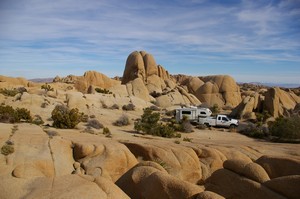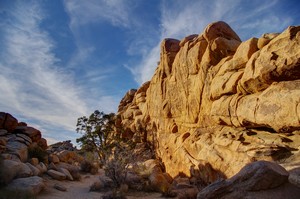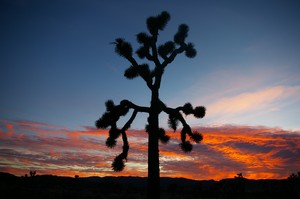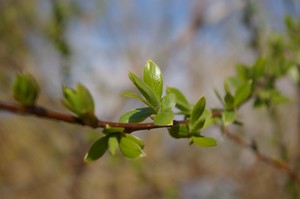 Jumbo Rocks campground is nestled amongst an extensive area of White Tank Granite, its many nooks
and crannies creating an ideal setting for our final few days here in Joshua Tree National Park.
The rocks surrounding our campsite offer the perfect opportunity for clambering about while the
Skull Rock Trail meanders over and between the granite allowing for an enjoyable late afternoon
stroll.
Jumbo Rocks campground is nestled amongst an extensive area of White Tank Granite, its many nooks
and crannies creating an ideal setting for our final few days here in Joshua Tree National Park.
The rocks surrounding our campsite offer the perfect opportunity for clambering about while the
Skull Rock Trail meanders over and between the granite allowing for an enjoyable late afternoon
stroll.
Our campsite is remarkably flat so we take advantage and detach the camper. Out on the Geology Tour Road we stop briefly at Squaw Tank. The dam is almost the same colour as the surrounding rock and seems to hide amongst the curves of the eroded granite in spite of its linear form. There are numerous dams of this type built by ranchers in the early nineteen hundreds to collect water for their livestock. Even in the dry winter months the sandy wash behind the wall is damp, little tufts of grass vividly green against the muted desert colours growing along the edges.
The unpaved track deteriorates from this point and we’re glad we don’t have the house with us. The road traces the line of one of the many faults in the park, along the northern edge of Pleasant Valley at the base of the Hexie Mountains where the meeting of the pale White Tank Monzogranite and the dark Pinto Gneiss create a clear line along the slope. As we turn south the double mounds of Malapai Hill become more obvious, the dark basalt mass rising from the valley floor in the distance, amidst the boulder piles.
 Its distinctive shape leaps out at us again a few days later from the top of Ryan Mountain. The trail
to the top is a short one and a half miles but a long hour’s climb of a thousand feet to the summit.
From the moment we step foot on the trail the views are stunning, the three hundred and sixty degree
panorama at the top, remarkable. Down on the valley floor the bare granite and boulder piles towered above us, individual rocks as
large as houses, walls reaching up to the sky, all in perfect keeping with the enormous scale of
this landscape. From up here they are mere bumps, the Joshua Trees, dots. It’s the larger scale
that dominates the scene from this perspective; the sculpted mountain ranges and gentler sweeps
of the valleys. It’s a breath-taking place for lunch in spite of the brisk wind and the views
on the way down are every bit as mesmerising.
Its distinctive shape leaps out at us again a few days later from the top of Ryan Mountain. The trail
to the top is a short one and a half miles but a long hour’s climb of a thousand feet to the summit.
From the moment we step foot on the trail the views are stunning, the three hundred and sixty degree
panorama at the top, remarkable. Down on the valley floor the bare granite and boulder piles towered above us, individual rocks as
large as houses, walls reaching up to the sky, all in perfect keeping with the enormous scale of
this landscape. From up here they are mere bumps, the Joshua Trees, dots. It’s the larger scale
that dominates the scene from this perspective; the sculpted mountain ranges and gentler sweeps
of the valleys. It’s a breath-taking place for lunch in spite of the brisk wind and the views
on the way down are every bit as mesmerising.

From the mountain we head to the short Hidden Valley trail where we’re immediately reminded of the
scale of the mere bumps as the path picks its way through gaps between the granite blocks before
emerging into a delightful area strewn with piles of boulders, enclosed by walls of rock and bathed
in the late afternoon sunlight.
 It’s hidden from the outside in but also from the inside out. It’s a world unto itself: warm, quiet,
still, stimulating and beautiful. The daylight fades as we head back and ends with the most wonderful sunset, silhouetting the Joshuas
against a backdrop of intense colours.
It’s hidden from the outside in but also from the inside out. It’s a world unto itself: warm, quiet,
still, stimulating and beautiful. The daylight fades as we head back and ends with the most wonderful sunset, silhouetting the Joshuas
against a backdrop of intense colours.
The world outside this microcosm provides the setting for our final hike in the park across the open
valley on Boy Scout Trail before following the meandering wash through another area of the light
coloured granite along Willow Hole Trail.
 The wash varies in width, narrow twisting passages giving way to much wider spaces where the
walls stand back and the view ahead opens before closing in on us again a half mile further along.
The name of the trail gives a clue of what’s ahead but doesn’t spoil the surprise: the bright
green shoots on the willowy limbs of the trees, a definite sign that spring is here in spite
of the
ice tucked against the canyon wall.
The wash varies in width, narrow twisting passages giving way to much wider spaces where the
walls stand back and the view ahead opens before closing in on us again a half mile further along.
The name of the trail gives a clue of what’s ahead but doesn’t spoil the surprise: the bright
green shoots on the willowy limbs of the trees, a definite sign that spring is here in spite
of the
ice tucked against the canyon wall.